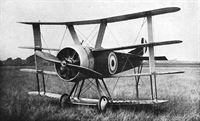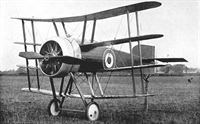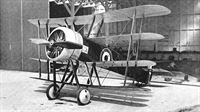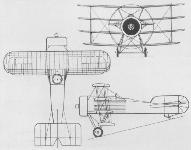P.Lewis The British Fighter since 1912 (Putnam)
J. Samuel White were among the few aircraft companies to attempt to exploit the quadruplane form and did so with their single-seat scout of 1916. The three upper wings were equal in span but the lowest was shorter than the others. Differing chords on each set of wings were incorporated and the 110 h.p. Clerget-engined machine was modified several times in efforts to improve it but N546 remained the only example of one more of the various unacceptable quadruplane types built.
Показать полностью
F.Mason The British Fighter since 1912 (Putnam)
Wight Quadruplane Scout
Towards the end of 1916 the Isle of Wight company, J Samuel White & Co, was engaged in work on a diminutive quadruplane single-seat scout, occasionally referred to as the Wight Type 4. Originally designed by Howard Wright (who had already left the company) the aircraft was powered by a 110hp Clerget rotary in a narrow-chord ‘oil sling’ cowling and, in its initial form featured wings of two different spans, the lowest being the shortest. Wing chord was only 2ft 9in, and tiny ailerons of some nine inches chord were fitted on the three upper wings. The undercarriage comprised single struts well raked outwards and wheels slotted into the lower wings’ leading edge; this arrangement, however, demanded an exceptionally long mounting for the tailskid in order to provide ground clearance for the lower wing’s trailing edge.
In order to employ an uninterrupted rectangular elevator, the horn-balanced rudder was hinged high on a fixed, triangular fin. As originally designed, the Scout featured twin parallel tubular interplane struts, but lack of side area resulted in these being crudely faired together by the simple expedient of wrapping them with fabric to create a single broad-chord surface; the struts in the lowest wing gap were not so treated. In all likelihood the aircraft was not flown in this somewhat dangerous configuration.
Early in 1917 a complete rebuild of the aircraft was begun. A much altered tail unit was designed, employing a split
elevator with cutout, thereby allowing an unbalanced rudder to be fitted, together with a much enlarged fin. The fuselage was less tapered in side elevation, resulting in a longer sternpost. A more conventional undercarriage was substituted with twin V-struts, the aft members passing through the lower wing to anchor on the lower longerons, allowing the wheels to be located well below the leading edge of the lower wing and thus permitting a conventionally-mounted tailskid.
Wing and aileron chords were increased so that the spars and interplane struts could be moved further apart and, with the increased side area of fuselage and tail, there was no need to fair the struts with fabric. A third and final configuration featured wings moved slightly further aft with progressively shorter spans from top to bottom, and with similar outward rake on the interplane struts; ailerons were only fitted on the two top wings.
Indeed the Scout appeared as a much safer-looking aeroplane, and Marcus Manton went ahead with flight tests. At some time towards the end of 1917 the prototype was purchased by the Admiralty, allotted the naval number N546, and evaluated at Martlesham. Manton stated that N546 ultimately crashed into a cemetary.
It is inconceivable that, despite its innovatory approach, the Quadruplane was ever seriously considered as a realistic operational fighter.
Type: Single-engine, single-seat, single-bay quadruplane scout.
Manufacturer: J Samuel White & Co, Cowes, Isle of Wight.
Powerplant: One 110hp Clerget rotary engine driving two-blade propeller.
Dimensions: Span, approx 19ft.
Prototype: One, N546.
Показать полностью
W.Green, G.Swanborough The Complete Book of Fighters
WIGHT QUADRUPLANE UK
Confusingly, aircraft of original design produced by the J S White company bore the appellation Wight, to link them with the location of the works at Cowes on the Isle of Wight. The last of some eight types developed under the direction of Howard T Wright as chief designer was the only Wight aircraft in the fighter category. This was a quadruplane of most unusual layout, in which the fuselage filled the gap between the two middle wings, with the upper and lower mainplanes carried above and below it on struts. At first, single wide-chord struts were used for the cabane and for the single wing bays between the upper, mid-upper and mid-lower wings, all of which had ailerons. The bottom wing, of shorter span, was carried on pairs of struts under the fuselage, and from the mid lower wing. The main wheels were carried on single struts each side and were notched into the bottom wing, with which the axle was in line. Construction was of wood, with mixed fabric and plywood covering. The engine was a 110 hp Clerget 9Z nine-cylinder rotary, but there is no record of the planned armament. Early flight testing, in mid-1916, led to a complete redesign and rebuild, by Howard T Wright and his team, with a fuselage of increased cross-section area and changed profile in side elevation, an enlarged tail unit and a new set of wings of varying chord. The original broad-chord struts gave way to pairs of narrow struts throughout and the undercarriage was lengthened. Possibly first tested at Martlesham Heath in February 1917, the Quadruplane acquired a third set of wings, with span progressively decreasing from top to bottom and ailerons on the two upper sets only. Further tests in July 1917 were unsatisfactory and the Quadruplane was written off in February 1918. No data have survived other than the dimensions.
Span 19 ft 0 in (5,79 m).
Length (final form), 20 ft 6 in (6,25 m).
Height, 10 ft 6 in (3,20 m).
Показать полностью
J.Bruce British Aeroplanes 1914-1918 (Putnam)
Wight Quadruplane Scout
THE only single-seat fighter to be built by J. S. White & Co. was a stumpy little quadruplane powered by a 110 h.p. Clerget rotary engine.
The illustrations show the stages in its development. As it first appeared, its fuselage in side elevation was roughly symmetrical about the thrust-line. The engine cowling had little camber, and its circular form was carefully faired into the flat sides of the fuselage. There was a triangular fin and an inadequate-looking horn-balanced rudder mounted wholly above the fuselage. The tailplane was mounted just below the upper longerons with its rear spar attached to the stern-post; a one-piece elevator was fitted.
The three top wings were of equal span, and were fitted with ailerons; the shorter bottom wing had none. Despite the extremely narrow chord, the double-camber aerofoil section was used. A double flying-wire and a double landing-wire were fitted on each side, and fabric fairings were applied to the top centre-section struts and to the interplane struts in the upper and middle gaps.
The arrangement of the undercarriage was probably unique. A single undercarriage strut on each side carried the wheels, which were notched into the leading edges of the bottom wings. The forward portion of the bottom centre-section was plywood-covered. This arrangement left little ground clearance for the lower wing, and a very tall tail-skid was required.
The original Wight quadruplane looked structurally unsafe, and some modifications seemed to be inevitable. What in fact happened was a complete re-design of the aircraft, and the result was really a new aeroplane. The new fuselage was of increased cross-sectional area and had its lower longerons straight and horizontal; the upper longerons curved downwards slightly to the stern-post. The tailplane was above the upper longerons, and a divided elevator permitted the use of a rudder which was the full length of the fin-post. A large, ugly fin of low aspect-ratio was fitted.
The wings were of different chords, the narrowest being that second from the bottom. As the illustration shows, the bracing wires were arranged conventionally, and the struts had no fabric fairings.� A new undercarriage, in which the wheels were wholly below the bottom wing, was fitted. This permitted the use of a more conventional tail-skid.
A third set of wings was later fitted. They were mounted slightly farther back on the fuselage, and were of progressively shorter span from top to bottom. The interplane struts had an outwards rake when seen in front elevation. Ailerons were fitted to the two top wings on each side: this simplified the aileron control run, for the cable was carried within the mainplane second from the bottom.
The ultimate fate of the Wight Quadruplane is not known, but the many modifications suggest that a satisfactory configuration was difficult to achieve. Doubtless it was hoped to produce an aeroplane of the calibre of the Sopwith Triplane, with a high degree of manoeuvrability; but the result was an ungainly aircraft which could not have failed to be unpopular with riggers on account of its complexity.
SPECIFICATION
Manufacturers: J. Samuel White & Co., East Cowes, Isle of Wight.
Power: 110 h.p. Clerget.
Dimensions: Span: 19 ft. Chord 2 ft 9 in.
Serial Number: N.546, built under Contract No. A.S.35342. The serial number N.14 was allotted for a “White Type 4 Quadruplane”, which may have been a version of the Wight Quadruplane, but the order was cancelled.
Показать полностью








